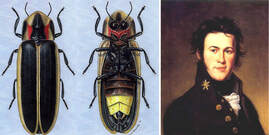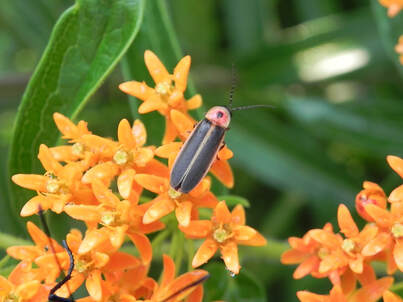Throughout the United States, habitat loss and degradation, light pollution, and climate change appear to be some of the primary drivers of decline of firefly populations.
Most firefly species—and their prey—depend on moist habitats, including wetlands, streams, and damp fields. In more urbanized areas, residential development and loss of leaf-litter habitat required during larval life stages is also a concern. Fireflies spend up to 95% of their lives in larval stages. They live in soil/mud/leaf litter and spend from 1-2 years growing until finally pupating to become adults. As adults, they only live 2-4 weeks. Females that have mated successfully need a place to lay eggs and gardens offer an oasis with a source of soil moisture good for larval development.
Light pollution is also a major concern for firefly populations. It can be caused by street and house lights, vehicle headlights, billboards, and even gas flares from oil fields. All sources of artificial light at night, or ALAN for short, have the potential to drive declines in firefly populations. Unfortunately for fireflies and other affected species, including humans, night sky brightness worldwide is only continuing to increase in both intensity and extent. More than three-quarters of firefly species in the United States are nocturnal, and these species use light of their own making to communicate, find mates or ward off predators.
No matter the reason for their decline, professionals agree that protecting, restoring, and enhancing firefly habitat is one of the best ways to conserve their populations.
Most firefly species—and their prey—depend on moist habitats, including wetlands, streams, and damp fields. In more urbanized areas, residential development and loss of leaf-litter habitat required during larval life stages is also a concern. Fireflies spend up to 95% of their lives in larval stages. They live in soil/mud/leaf litter and spend from 1-2 years growing until finally pupating to become adults. As adults, they only live 2-4 weeks. Females that have mated successfully need a place to lay eggs and gardens offer an oasis with a source of soil moisture good for larval development.
Light pollution is also a major concern for firefly populations. It can be caused by street and house lights, vehicle headlights, billboards, and even gas flares from oil fields. All sources of artificial light at night, or ALAN for short, have the potential to drive declines in firefly populations. Unfortunately for fireflies and other affected species, including humans, night sky brightness worldwide is only continuing to increase in both intensity and extent. More than three-quarters of firefly species in the United States are nocturnal, and these species use light of their own making to communicate, find mates or ward off predators.
No matter the reason for their decline, professionals agree that protecting, restoring, and enhancing firefly habitat is one of the best ways to conserve their populations.
Additional resources:
For more information, see this DNR Website on Say's Firefly.
Learn more about Thomas Say - University of Evansville .
For more information, see this DNR Website on Say's Firefly.
Learn more about Thomas Say - University of Evansville .


